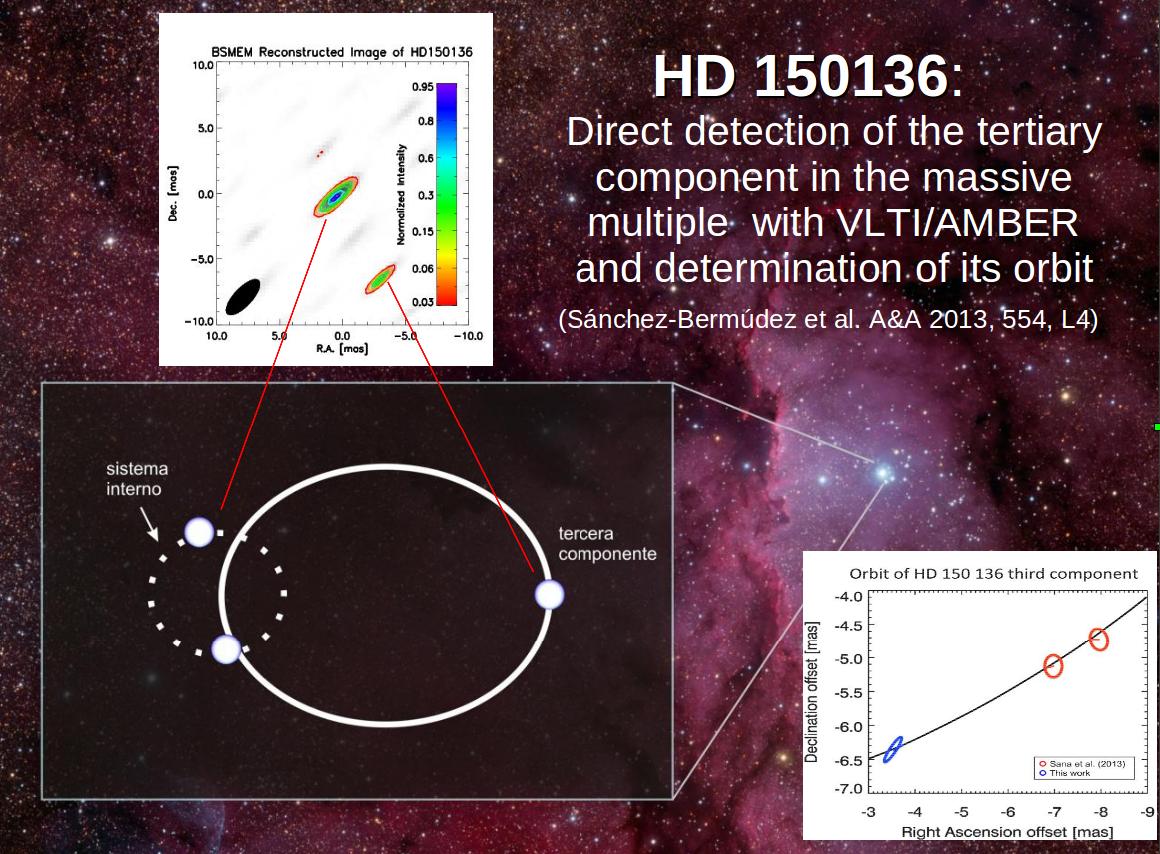Massive star formation
VLTI Studies of the Formation of Massive Stars
The evolution of galaxies cannot be fully understood without the study of massive stars (M > 8Msun). This is due to the strong interstellar enrichment produced by these stars throughout their life-times. However, despite of their importance, we still lack a complete theory of their evolution. This is mainly because high-mass stars are formed in the densest regions of molecular clouds and, hence, are highly extincted. Furthermore, this kind of objects are rare compared with lower mass stars and are located at large distances (d > 1 kilo-parsec) from us. One of the most important open questions associated with the formation of massive stars is the way in which these objects gain mass during their formation. In principle, the formation of massive stars can be considered similar to an scaled version of the formation of low-mass stars, in which a star gains its mass due to the accretion of material from a disk. In the high-mass regime, this scenario is constrained by the fact that the strong stellar radiation pressure produced by the forming star might affect the accretion process, even preventing the star to grow in mass. To aim at resolving this problem, important theoretical work has been proposed to characterize the early phases of massive young stellar objects (MYSOs). Recent 3D hydrodynamic simulations of massive star formation show that spiral rotational structures (i.e. accretion disks) with high accretion rates (>10-4 Msun/yr) are able to overcome the strong stellar radiation, allowing accretion of material into the central source. One of the most striking features of massive stars is the observed high fraction of multiple systems (Mason et al. 2009, AJ 137, 3358; Sana et al. 2014, ApJS 215, 75). Accurate, high angular resolution data on massive multiples are necessary to obtain the fundamental constraints on their formation (competitive accretion, monolithic collapse, mergers; Krumholz et al. 2009, Sci 323, 754; Bonnell et al. 2006, MNRAS 370, 488; 2011, MNRAS 410, 2339; Zinnecker & Yorke, 2007, ARA&A 45, 481).
Many of these theoretical predictions still have to be tested consistently against observations. In our previous research project, we performed high angular resolution observations to study different aspects of massive stars: (i) Multiplicity: using AMBER/VLTI, we imaged for the first time the tertiary component of two multiple massive systems (HD150136 and Herschel 36; Sánchez-Bermúdez et al. 2013, A&A 554, L4; 2014, A&A 572, L1); (ii) interaction of the stellar winds with the ISM: using Sparse Aperture Masking (SAM) observations with NACO, we imaged the bow-shock structure of the sources and determined the main processes responsible of their emission as well as their orbital planes (Sánchez-Bermúdez et al. 2014, 567, A21); (iii) we studied the early stages of massive stars, in particular the young massive stellar object IRS9A using both NACO/SAM data and near-infrared spectroscopic data obtained with CRIRES/VLT. Our observations revealed the existence of a central star surrounded by a compact disk and an outer envelope (Sánchez-Bermúdez et al. 2015, A&A, in press).

Technical application: Holographic imaging for crowded fields (i.e. the Galactic Center)
Holographic imaging is derived from speckle imaging, a pre-AO technique to obtain diffraction-limited images at large telescopes. It consists of recording large series of exposures with integration times shorter than the atmospheric coherence time. Stars appear as speckle clouds in these short exposure images. Diffraction limited images can be reconstructed from these data by various algorithms (e.g. the shift-and-add (SSA) algorithm). SSA is popular because it is simple, with low requirements on computing time. On the downside, it only uses the information and photons in the brightest speckle and is therefore inefficient and leads to large extended “seeing” halos around the stars. R. Schödel has recently revisited the so-called speckle holography technique (in the following called “holographic imaging”, see Schödel et al. 2011, The Messenger, vol. 150, p. 26-29). Holography is powerful because it uses the information and flux content of the entire instantaneous PSF of a short-exposure, not just the brightest speckle. Efficiency is further increased in holography because frame-selection is hardly necessary. R. Schödel programmed a new holography algorithm that is based on iterative image reconstruction. Knowledge of the relative positions and fluxes of sources from previous iterations allows the observer to extract a highly accurate instantaneous PSF from each speckle frame, even in extremely crowded fields, like globular clusters or the Galactic center. A key novelty of the algorithm is also that it can simultaneously use multiple reference stars, thereby suppressing systematic errors and enabling the use of relatively faint reference stars. Holography supersedes AO and lucky imaging at short NIR and at optical wavelengths.
A particular advantage of holography is that it allows the observer to make use of many reference stars distributed across the field. In crowded fields at least one, and usually several sufficiently bright stars are present within the isoplanatic angle in any direction. Holography is thus not (or hardly) subject to pointing restrictions and anisoplanatism and can allow one to obtain images with a stable PSF and thus accurate photometric calibration across a large FOV. Holographic imaging also leads to higher image quality and greater sensitivity in optical speckle imaging data (e.g., AstraLuxSur, FASTCAM) and can provide large FOVs almost free of anisoplanatic effects on instruments such as NaCo, HAWK-I, or the future ESO AO instrument ERIS. Thus, the technique can be of great interest for science cases ranging from the Galactic centre, population and kinematics in globular clusters, to proper motion and multiplicity studies in embedded star forming regions. Holography can also be combined with AO observations, which may be of particular relevance for observations where AO does not yet deliver a stable PSF.
